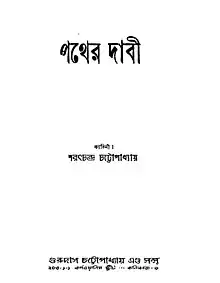Pather Dabi
Pather Dabi (The Right of Way; or Demands of the Road) is a Bengali novel written by Sarat Chandra Chattopadhyay. It was first published as a novel in 1926, after having been initially serialized in the journal Bangabani. The book is set in British-occupied India.[1][2][3]

Content
The book is about a secret society named Pather Dabi whose goal is to free India from British rule.And Sarat Chandra chattopadhyay played a great role for making a Revolutionary mind in young Indians,which gives an effort to the Indians to free from this Torture by British.Sharat Chandra chattopadhyay helped to create an independent consciousness among the Indians.And he also mentioned that independence is the only way to save Indians and also mentioned that proper relationship is not only family relations but also a relation with anyone who is struggling to save India from the British rule, through the words of his novel.The leader of the organization is Sabyasachi Mallick, who is described as being highly educated, having studied medicine, engineering, and law in Europe and America.[3][4] Sabyasachi is also endowed with physical strength and courage which enable him to elude British intelligence. His physical feats include swimming across a torrential river, and traversing the Eastern Himalayas on foot.[4]
Another major character, Apurba , a member of Pather Dabi, described as a contemptible figure. Emotional and impressionable, Apurba grieves at the colonial rule. He is, however, also weak, timid, and venal. A scene in the book depicts him being humiliated at a railway station by white youth. His obsession with caste purity even during illness and danger is depicted with contempt. Eventually, Apurba becomes a police informer. The main narrative in the book follows Apurba with Sabyasachi appearing unexpectedly, and disappearing as mysteriously.[5]
Sabyasachi does not believe in the caste system, and towards the end of the book pleads for the destruction of "all that is eternal (sanatan), ancient, and decaying--[in] religion, society, tradition" on the ground that these are "enemies of the nation."[6]
Other important characters in the novel are Sumitra and Bharati, who work alongside men in defiance of the traditional social conventions of the day. Sumitra is described as being beautiful and intelligent, besides being a nationalist. In the book, Sumitra makes an impassioned argument for why it is appropriate for a woman to leave a loveless marriage.[5]
According to a review of the book in the Indian Express:
The story touches upon contemporary issues ranging from untouchability, orthodoxy and faith to rich-poor divide and the status of women in the society, criticising the British policies and also India’s inherent customs of religion and social structure with the same intensity.[3]
Reception
- The first edition of the book, comprising 5,000 copies, was sold out within a week. Subsequent to this, the book was banned on 4 January 1921 by British Government after due consultation of the then Advocate General of West Bengal.[3][7]
- Tanika Sarkar, while analyzing the character of Sabyasachi, has observed: "Capable, literally of everything, [Sabyasachi] is the first superman in serious Bengali fiction, always a million times larger than life.[8]
- It has been suggested that Sabyasachi's usage of various disguises to escape police detection have conspicuous parallels with the modus operandi of Surya Sen.[9]
Sarat Chandra and Tagore
A correspondence between Sarat Chandra and Rabindranath Tagore took place after the ban imposed on the book.[7] Tagore justified the ban on the book, on the ground that it was a seditious book, while Sarat justified his book on the ground that "throughout India, large numbers of people are being imprisoned or externed by the government on flimsy grounds without trial or in flagrant miscarriage of justice."[10][11] Sarat agreed with Tagore's assessment that the book caused the reader to become disenchanted with the British government, stating that this indeed was his intention in writing it.[12]
Film
The 1977 film Sabyasachi (film), starring Uttam Kumar, is based on this book. The co starrer were Tarun Kumar, Bikash Roy, Supriya Choudhury.[3]
References
- Joya Chatterji (2002). Bengal Divided: Hindu Communalism and Partition, 1932-1947. Cambridge South Asian Studies. pp. vii–viii.
- Sarat Chandra Chattopadhyay and (tr.) Prasenjit Mukherjee (2011). Pather Dabi The Right of Way. Rupa & Co.CS1 maint: uses authors parameter (link)
- "Remembering Sarat Chandra Chattopadhyay, the 'Awara Masiha'". Indian Express. 15 September 2015. Retrieved 2 November 2016.
- Joya Chatterji (2002). Bengal Divided: Hindu Communalism and Partition, 1932-1947. Cambridge South Asian Studies. p. 164.
- Joya Chatterji (2002). Bengal Divided: Hindu Communalism and Partition, 1932-1947. Cambridge South Asian Studies. pp. 164–5.
- Joya Chatterji (2002). Bengal Divided: Hindu Communalism and Partition, 1932-1947. Cambridge South Asian Studies. p. 165.
- Sarat Chandra Chattopadhyay and (tr.) Prasenjit Mukherjee (2011). Pather Dabi The Right of Way. Rupa & Co. pp. vii–ix.CS1 maint: uses authors parameter (link)
- Tanika Sarkar (1987). Bengal 1928-1934: The Politics of Protest. Oxford University Press. p. 24.
- Stephen Morton (2013). States of Emergency: Colonialism, Literature and Law. Liverpool University Press. pp. 80–1.
- Sarat Chandra Chattopadhyay and (tr.) Prasenjit Mukherjee (2011). Pather Dabi The Right of Way. Rupa & Co. pp. x–xii.CS1 maint: uses authors parameter (link)
- "A human being rather than a flawless god". The Hindu. 6 December 2011. Retrieved 2 November 2016.
- Sarat Chandra Chattopadhyay and (tr.) Prasenjit Mukherjee (2011). Pather Dabi The Right of Way. Rupa & Co. pp. xii.CS1 maint: uses authors parameter (link)